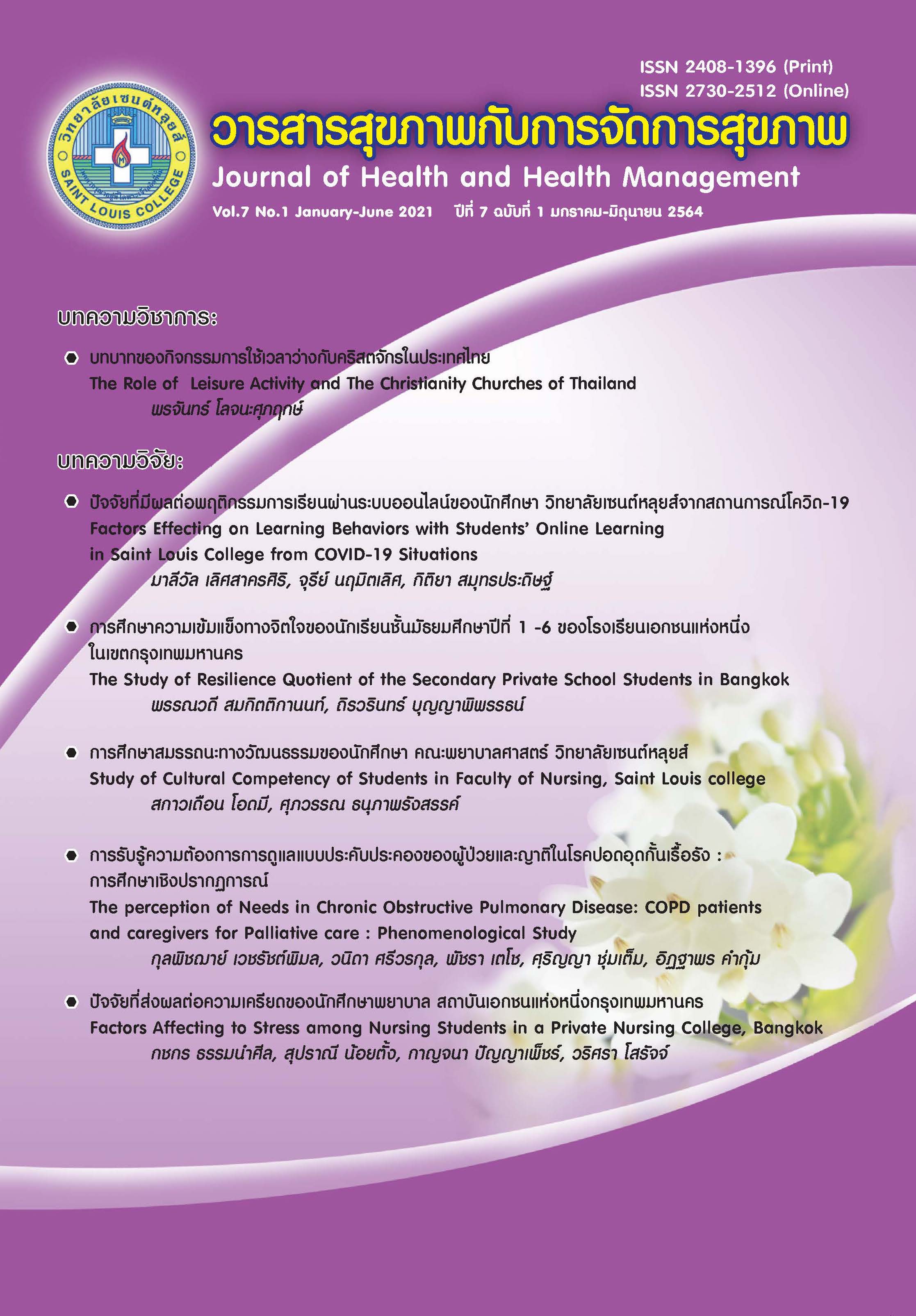The perception of Needs in Chronic Obstructive Pulmonary Disease: COPD patients and caregivers for Palliative care : Phenomenological Study
Keywords:
perception needs, palliative care, patients, relatives, Chronic Obstructive Pulmonary DiseaseAbstract
The objectives of this phenomenon study of chronic obstructive pulmonary disease (COPD), the perception and need for palliative care of patients with COPD and their relatives. The sample consisted of 11 patients and 11 relatives total 22 patients and their relatives. Data were collected by in-depth interviews, focus group and non-participatory observation. Three experts had validated the Perception and Need questionnaire with the result of CVI 0.82 . Data of questionnaire were analyzed by statistical computer program while the qualitative data were analysed by content analysis.The research results revealed that patients perceived COPD as an incurable disease.They felt it was a burden on the family and it incurred unnecessary cost for medical treatment. The relatives and caregivers felt that these patients need palliative care. The relatives and caregivers also believed that it was an incurable and caused undue suffering. They understood the nature and the course of the disease. They knew how to handle the basic conditions of the patients and accept the consequences of the patients’condition, economic and social reconciliation, income reduction as a result from the time off work, or the need to hire someone to care for the patients. However, most caretakers do not understand the principles of palliative care. It was found that more than 60 percent wanted to learn the model of palliative care. Therefore, palliative care concepts and practices should be promoted in the patients and their relatives have a proper understanding of palliative care. Palliative care skills are developed to help COPD patients improve their health and quality of life. In doing so, when it is time to leave the present life, the patients and family members will have good memories filled with love and compassions.
References
กมลพร สกุลพงศ์, วิริยา โพธิ์ขวาง-ยุสท์, และเบญจวรรณ งามวงศ์วิวัฒน์. (2560). การพัฒนารูปแบบการดูแลแบบประคับประคองที่ใช้ชุมชนเป็นฐานสำหรับผู้ป่วยมะเร็ง: กรณีศึกษาบ้านปันรักสุราษฎร์ธานี.วารสารพยาบาลกระทรวงสาธารณสุข, 27(ฉบับพิเศษ), 90-103.
กระทรวงสาธารณสุข. (2562). รายงานสถานการณ์โรค NCDS. สืบค้นจาก https://ddc.moph.go.th/uploads/publish/1035820201005073556.pdf
จเร บุญเรือง, จอม สุวรรณ, เรวดี เพชรศิราสัณห์, เจนเนตร พลเพชร, และลัดดา เถียมวงศ์. (2559). ความสัมพันธ์ระหว่างลักษณะความเจ็บป่วยภาวะสุขภาพและลักษณะบุคลกับการกำเริบรุนแรงเฉียบพลันที่เกิดขึ้นภายในช่วงระยะเวลาอันสั้นของผู้ป่วยปอดอุดกั้นเรื้อรัง: การศึกษาติดตามไปข้างหน้า 3 เดือน. วารสารวิชาการสาธารณสุข, 25(6), 982.
ทัศนีย์ ทองประทีป. (2552). พยาบาล:เพื่อนร่วมทุกข์ผู้ป่วยระยะสุดท้าย (พิมพ์ครั้งที่ 2). กรุงเทพ ฯ: บริษัท วี พริ้นท์ จำกัด.
ธารีรัตน์ อนันต์ชัยทรัพย์. (2555). แนวปฏิบัติบริการสาธารณสุขโรคปอดอุดกั้นเรื้อรัง พ.ศ. 2553. สงขลา: คณะแพทยศาสตร์ มหาวิทยาลัยสงขลานครินทร์.
เมธิณี จันติยะ, พนิตนาฎ ชำนาญเสือ, และผุสดี คุณาพันธ์. (2554). คุณภาพชีวิตของผู้ป่วยโรคปอดอุดกั้นเรื้อรังที่มารับบริการ โรงพยาบาลสระบุรี. รามาธิบดีพยาบาลสาร, 17(3), 328-341.
วัชราภรณ์ เปาโรหิต, และสิริพร บุญเจริญพานิช. (2560). คุณภาพชีวิตข้าราชการบำนาญกองทัพอากาศและครอบครัวที่ป่วยด้วยโรคเรื้อรังและได้รับการดูแลแบบประคับประคอง. วารสารพยาบาลทหารบก, 18(3), 244-250.
ศรีเวียง ไพโรจน์กุล และปาริชาติ เพียสุพรรณ์. (2560). แนวทางการดำเนินงาน ศูนย์ดูแลประคับประคองในโรงพยาบาล ศูนย์การุญรักษ์ Operational Guideline for Hospital Palliative Care Program. ขอนแก่น: โรงพิมพ์คลังนานา วิทยา.
Agresti, A. (2002). Categorical Data Analysis (2nd Edition). Inc New York: John Wiley & Sons Lincoln, Y. S. & Guba, E. G. (1985). Naturalistic Inquiry. Beverly Hills, CA: Sage Publications.
Nuccio, T., & Nuccio, P. (2009). Give Them Comfort: Controlling COPD Symptoms at the End of Life (Part II). RT: The Journal For Respiratory Care Practitioners, 30(6), 24-28.
World Health Organization. (2002). The world health report 2002: reducing risks, promoting healthy life. World Health Organization.
World Health Organization. (2020). Palliative Care. Retrieved August 2020 from https://www.who.int/news-room/fact-sheets/detail/palliative-care




